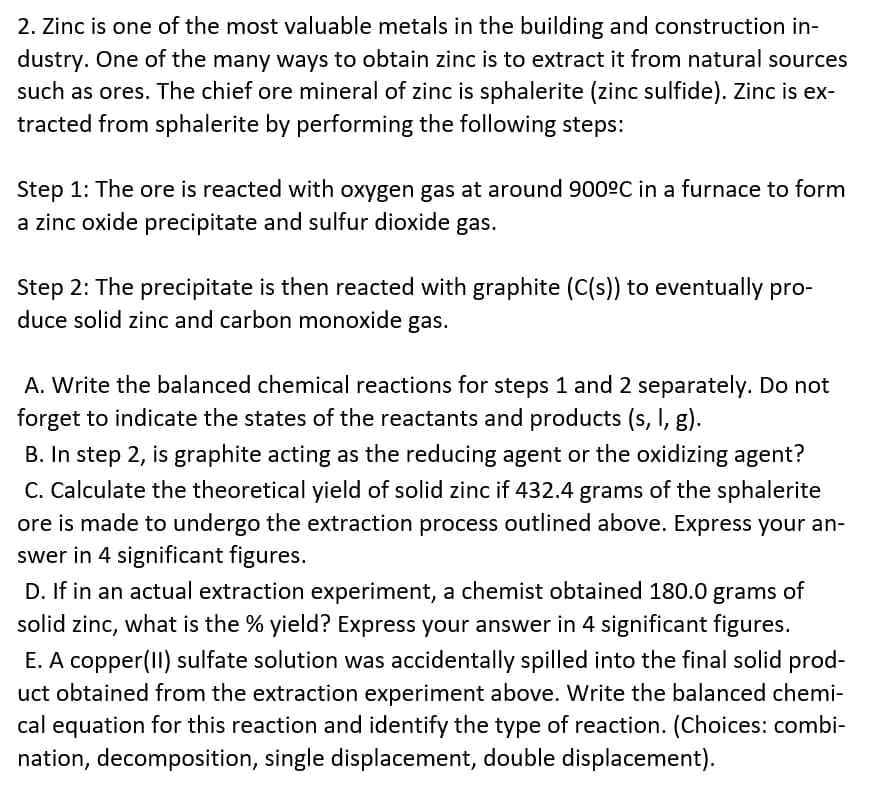2. Zinc is one of the most valuable metals in the building and construction in- dustry. One of the many ways to obtain zinc is to extract it from natural sources such as ores. The chief ore mineral of zinc is sphalerite (zinc sulfide). Zinc is ex- tracted from sphalerite by performing the following steps: Step 1: The ore is reacted with oxygen gas at around 900ºC in a furnace to form a zinc oxide precipitate and sulfur dioxide gas. Step 2: The precipitate is then reacted with graphite (C(s)) to eventually pro- duce solid zinc and carbon monoxide gas. A. Write the balanced chemical reactions for steps 1 and 2 separately. Do not forget to indicate the states of the reactants and products (s, I, g). B. In step 2, is graphite acting as the reducing agent or the oxidizing agent? C. Calculate the theoretical yield of solid zinc if 432.4 grams of the sphalerite ore is made to undergo the extraction process outlined above. Express your an- swer in 4 significant figures.
2. Zinc is one of the most valuable metals in the building and construction in- dustry. One of the many ways to obtain zinc is to extract it from natural sources such as ores. The chief ore mineral of zinc is sphalerite (zinc sulfide). Zinc is ex- tracted from sphalerite by performing the following steps: Step 1: The ore is reacted with oxygen gas at around 900ºC in a furnace to form a zinc oxide precipitate and sulfur dioxide gas. Step 2: The precipitate is then reacted with graphite (C(s)) to eventually pro- duce solid zinc and carbon monoxide gas. A. Write the balanced chemical reactions for steps 1 and 2 separately. Do not forget to indicate the states of the reactants and products (s, I, g). B. In step 2, is graphite acting as the reducing agent or the oxidizing agent? C. Calculate the theoretical yield of solid zinc if 432.4 grams of the sphalerite ore is made to undergo the extraction process outlined above. Express your an- swer in 4 significant figures.
Introductory Chemistry: A Foundation
9th Edition
ISBN:9781337399425
Author:Steven S. Zumdahl, Donald J. DeCoste
Publisher:Steven S. Zumdahl, Donald J. DeCoste
Chapter7: Reactions In Aqueous Solutions
Section: Chapter Questions
Problem 16CR: The element carbon undergoes many inorganic reactions, as well as being the basis for the field of...
Related questions
Question

Transcribed Image Text:2. Zinc is one of the most valuable metals in the building and construction in-
dustry. One of the many ways to obtain zinc is to extract it from natural sources
such as ores. The chief ore mineral of zinc is sphalerite (zinc sulfide). Zinc is ex-
tracted from sphalerite by performing the following steps:
Step 1: The ore is reacted with oxygen gas at around 900ºC in a furnace to form
a zinc oxide precipitate and sulfur dioxide gas.
Step 2: The precipitate is then reacted with graphite (C(s)) to eventually pro-
duce solid zinc and carbon monoxide gas.
A. Write the balanced chemical reactions for steps 1 and 2 separately. Do not
forget to indicate the states of the reactants and products (s, I, g).
B. In step 2, is graphite acting as the reducing agent or the oxidizing agent?
C. Calculate the theoretical yield of solid zinc if 432.4 grams of the sphalerite
ore is made to undergo the extraction process outlined above. Express your an-
swer in 4 significant figures.
D. If in an actual extraction experiment, a chemist obtained 180.0 grams of
solid zinc, what is the % yield? Express your answer in 4 significant figures.
E. A copper(II) sulfate solution was accidentally spilled into the final solid prod-
uct obtained from the extraction experiment above. Write the balanced chemi-
cal equation for this reaction and identify the type of reaction. (Choices: combi-
nation, decomposition, single displacement, double displacement).
Expert Solution
This question has been solved!
Explore an expertly crafted, step-by-step solution for a thorough understanding of key concepts.
Step by step
Solved in 3 steps with 1 images

Knowledge Booster
Learn more about
Need a deep-dive on the concept behind this application? Look no further. Learn more about this topic, chemistry and related others by exploring similar questions and additional content below.Recommended textbooks for you

Introductory Chemistry: A Foundation
Chemistry
ISBN:
9781337399425
Author:
Steven S. Zumdahl, Donald J. DeCoste
Publisher:
Cengage Learning

Chemistry: Principles and Practice
Chemistry
ISBN:
9780534420123
Author:
Daniel L. Reger, Scott R. Goode, David W. Ball, Edward Mercer
Publisher:
Cengage Learning

Chemistry: The Molecular Science
Chemistry
ISBN:
9781285199047
Author:
John W. Moore, Conrad L. Stanitski
Publisher:
Cengage Learning

Introductory Chemistry: A Foundation
Chemistry
ISBN:
9781337399425
Author:
Steven S. Zumdahl, Donald J. DeCoste
Publisher:
Cengage Learning

Chemistry: Principles and Practice
Chemistry
ISBN:
9780534420123
Author:
Daniel L. Reger, Scott R. Goode, David W. Ball, Edward Mercer
Publisher:
Cengage Learning

Chemistry: The Molecular Science
Chemistry
ISBN:
9781285199047
Author:
John W. Moore, Conrad L. Stanitski
Publisher:
Cengage Learning

Chemistry: Principles and Reactions
Chemistry
ISBN:
9781305079373
Author:
William L. Masterton, Cecile N. Hurley
Publisher:
Cengage Learning

Chemistry: An Atoms First Approach
Chemistry
ISBN:
9781305079243
Author:
Steven S. Zumdahl, Susan A. Zumdahl
Publisher:
Cengage Learning
